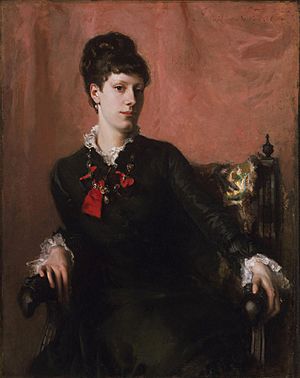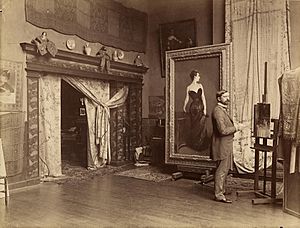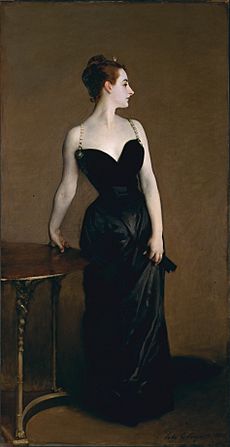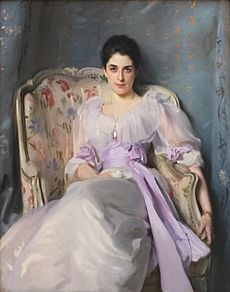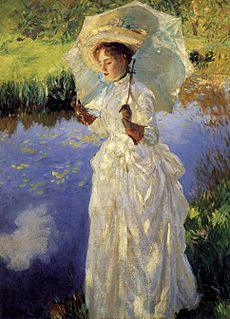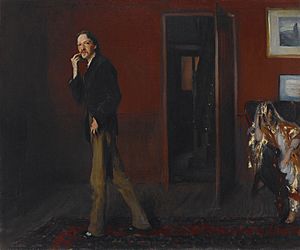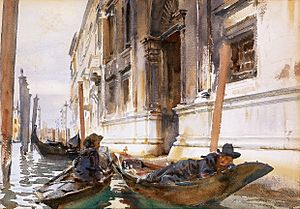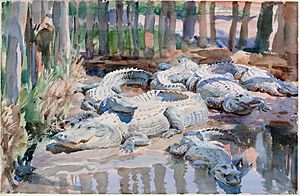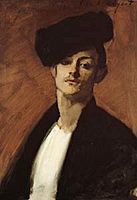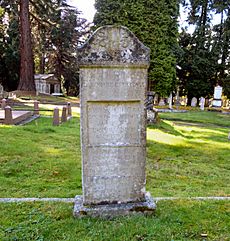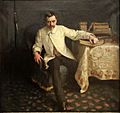John Singer Sargent facts for kids
Quick facts for kids
John Singer Sargent
|
|
|---|---|
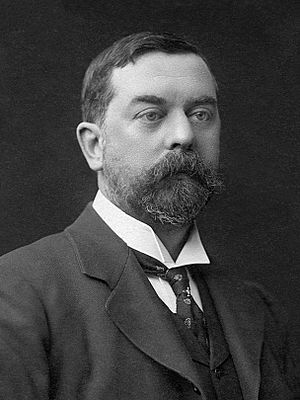
Sargent photographed by James E. Purdy in 1903
|
|
| Born | January 12, 1856 |
| Died | April 14, 1925 (aged 69) London, England
|
| Resting place | Brookwood Cemetery |
| Nationality | American |
| Education | École nationale supérieure des Beaux-Arts |
| Known for | Painting |
|
Notable work
|
|
| Movement | Impressionism |
John Singer Sargent (born January 12, 1856 – died April 14, 1925) was an American artist. He is known as one of the best portrait painters of his time. He painted many rich and important people from the Edwardian era.
Sargent created about 900 oil paintings and over 2,000 watercolors. He also made countless sketches and charcoal drawings. His art shows his travels around the world. He visited places like Venice, Spain, the Middle East, and parts of the United States.
He was born in Florence, Italy, to American parents. He studied art in Paris, France. Later, he moved to London, England. He spent most of his life in Europe. He became famous around the world for his portraits.
One of his early paintings, Portrait of Madame X, caused a scandal in Paris. This happened when he showed it at the Paris Salon in the 1880s. After this, Sargent moved to England. There, he continued his successful career as a portrait artist.
Sargent was very skilled at painting. He could draw well with his brush. His formal portraits were grand and impressive. But his informal studies and landscape paintings showed he knew about Impressionism. Later in life, Sargent felt tired of painting formal portraits. He spent more time painting large wall murals and painting outdoors.
Contents
Early Life and Family
John Singer Sargent came from an important American family. His father, FitzWilliam, was an eye surgeon. After a sad family event, his parents decided to travel in Europe. They ended up living in different countries for the rest of their lives.
Sargent was born in Florence, Italy, in 1856. This was because his parents stopped there during a sickness. His parents moved often, staying in different places in France, Germany, Italy, and Switzerland.
Young Sargent was a lively child. He loved outdoor activities more than school. His mother believed that visiting museums and churches would teach him well. Because they moved so much, he did not go to school formally very often.
His mother was a good amateur artist. His father was also skilled at drawing for medical books. Early on, his mother gave him sketchbooks. She encouraged him to draw what he saw. Sargent loved to draw ships and detailed landscapes.
When he was thirteen, his mother noticed his talent. She said he had a "remarkably quick and correct eye." He took some watercolor lessons from a German painter named Carl Welsch. Even without much formal schooling, Sargent grew up to be very smart. He was good at art, music, and reading. He could speak English, French, Italian, and German fluently.
Art Training and Learning
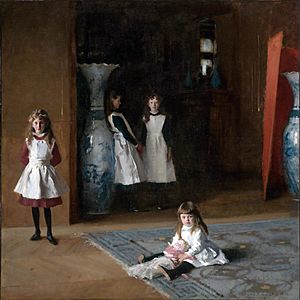
Sargent tried to study at an art academy in Florence, but it was being reorganized. So, he went to Paris. There, he began studying art with a young French portrait painter named Carolus-Duran. Carolus-Duran was known for his bold painting style. He taught Sargent from 1874 to 1878.
In 1874, Sargent passed a difficult test to get into the École des Beaux-Arts. This was the best art school in France. He took drawing classes there and won a silver prize. He also spent a lot of time practicing on his own. He drew in museums and painted in a studio he shared with his friend James Carroll Beckwith. Sargent also took some lessons from Léon Bonnat.
Carolus-Duran's studio was modern. They did not use the old way of painting. Instead, they painted directly onto the canvas with thick brushes. This style was inspired by the artist Diego Velázquez. Sargent became the best student very quickly. Another artist, Julian Alden Weir, met Sargent in 1874. He said Sargent was "one of the most talented fellows I have ever come across."
Sargent's good French and great talent made him popular. He met famous artists like Edgar Degas, Auguste Rodin, Claude Monet, and James Abbott McNeill Whistler.
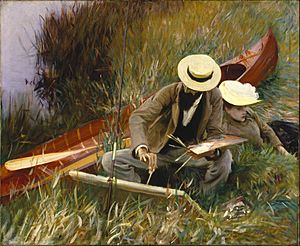
At first, Sargent loved painting landscapes more than portraits. His early sketches are full of mountains, seascapes, and buildings. But Carolus-Duran's skill in portraits guided Sargent in that direction. Painting portraits was the best way to become famous and earn money.
Sargent's first important portrait was of his friend Fanny Watts in 1877. It was also his first painting shown at the Paris Salon. People noticed its well-done pose. His second Salon entry was Oyster Gatherers of Cançale. This was an impressionistic painting that received good reviews.
Starting His Career

In 1879, when Sargent was 23, he painted a portrait of his teacher, Carolus-Duran. This painting was very skillful and people liked it. It showed the kind of work Sargent would do later. Showing it at the Paris Salon honored his teacher and helped him get portrait jobs.
After leaving Carolus-Duran's studio, Sargent visited Spain. He loved studying the paintings of Diego Velázquez. He learned a lot from Velázquez's style. In Spain, he also fell in love with Spanish music and dance. This trip helped him create his early masterpiece, El Jaleo (1882). Music was always important in his life. He was a good piano player and supported modern composers like Gabriel Fauré. Trips to Italy gave him ideas for paintings of Venetian street scenes.
When he returned to Paris, Sargent quickly got many portrait commissions. His career had begun! He worked steadily for the next twenty-five years. He filled time between jobs by painting friends and colleagues. His good manners, perfect French, and great skill made him stand out. He quickly became famous. He set high prices and turned down clients he didn't want to paint.
Famous Artworks
Portraits
Nineteenth-Century Portraits
In the early 1880s, Sargent often showed portraits at the Salon. These were usually full-length paintings of women. He continued to get good reviews.
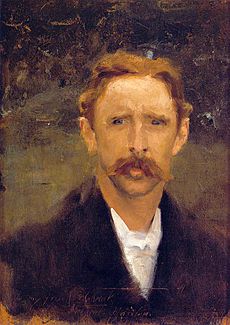
Sargent's best portraits show the unique personality of the people he painted. Many people think only Velázquez was as good as Sargent at this. Velázquez's influence can be seen in Sargent's The Daughters of Edward Darley Boit, painted in 1882. This painting uses unusual composition and lighting. One of his most loved works from the 1880s was The Lady with the Rose (1882). This was a portrait of Charlotte Burckhardt, a close friend.
His most talked-about work was Portrait of Madame X (1884). This painting is now seen as one of his best. Sargent himself said it was his favorite. But when it was shown in Paris in 1884, it caused a lot of negative reactions. This likely made Sargent decide to move to London.
Before moving to England, Sargent started sending paintings to the Royal Academy. These included Dr. Pozzi at Home (1881), a colorful portrait, and Mrs. Henry White (1883). These paintings helped him get more portrait jobs. He moved to London in 1886. The writer Henry James had encouraged him to move there.
English art critics were not very welcoming at first. They thought his painting style was too "French." But with help from Mrs. Henry White, Sargent soon gained the respect of English art lovers.
Sargent spent a lot of time painting outdoors in the English countryside. In 1885, he visited Claude Monet in France. There, Sargent painted one of his most Impressionistic portraits. It showed Monet painting outdoors with his wife nearby. Sargent sometimes used Impressionistic techniques. He bought four of Monet's paintings for his own collection.
Sargent also painted his artist friend Paul César Helleu outdoors. A photo similar to the painting suggests Sargent sometimes used photos to help him with his art. Through Helleu, Sargent met and painted the famous sculptor Auguste Rodin in 1884.
Sargent's first big success at the Royal Academy came in 1887. This was with his painting Carnation, Lily, Lily, Rose. It was a large painting of two young girls lighting lanterns in an English garden. The Tate Gallery bought the painting right away.
His first trip to New York and Boston as a professional artist was in 1887–88. He got over 20 important jobs, including portraits of Isabella Stewart Gardner. In Boston, Sargent had his first solo art show. He became friends with painter Dennis Miller Bunker.
Back in London, Sargent was very busy. His way of working was well-established. He would visit the client's home to see where the painting would hang. He often looked at their clothes to pick the right outfit. Some portraits were done in the client's home, but most were done in his studio. He usually needed eight to ten sittings from his clients. He would try to capture their face in just one sitting. He often chatted with his clients and sometimes played the piano for them. Sargent usually painted directly with oil paint, without many sketches first.
Sargent did all the work himself. He prepared his canvases, varnished paintings, and arranged for shipping. He charged about $5,000 per portrait. Some American clients even traveled to London to have him paint them.
Around 1890, Sargent painted two bold portraits that were not commissioned. One was of actress Ellen Terry as Lady Macbeth. The other was of the popular Spanish dancer La Carmencita. Sargent became a full member of the Royal Academy. In the 1890s, he painted about fourteen portraits each year. One of the most beautiful was Lady Agnew of Lochnaw, from 1892. He was called "the Van Dyck of our times." Even though Sargent lived abroad, he returned to the United States many times for portrait jobs.
Sargent showed nine of his portraits at the 1893 World's Columbian Exposition in Chicago.
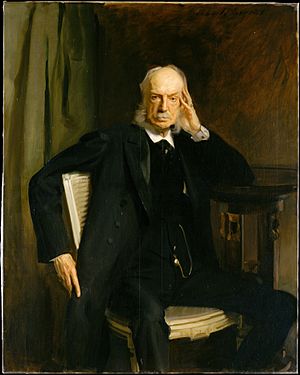
Sargent painted three portraits of the writer Robert Louis Stevenson. The second one, Portrait of Robert Louis Stevenson and his Wife (1885), is very well known. He also painted two U.S. presidents: Theodore Roosevelt and Woodrow Wilson.
In 1896, the Metropolitan Museum of Art asked Sargent to paint a portrait of Henry Gurdon Marquand. Marquand was the second president of the museum.
Asher Wertheimer, a rich art dealer in London, asked Sargent to paint twelve portraits of his family. This was Sargent's biggest job from one person. The Wertheimer portraits show a friendly feeling between the artist and the family. Wertheimer gave most of these paintings to the National Gallery, London. Many of Sargent's important works are in museums in the United States.
Twentieth-Century Portraits

By 1900, Sargent was very famous. Even though he was only in his forties, he started to travel more. He spent less time painting portraits. His painting An Interior in Venice (1900), showing the Curtis family in their grand home, was a big success. One of Sargent's last major portraits in his bold style was of Lord Ribblesdale, in 1902. Between 1900 and 1907, Sargent continued to paint many oil portraits. He also made hundreds of portrait drawings. In 1901, he bought the house next door to his home to make a bigger studio.
In 1907, at 51 years old, Sargent officially closed his portrait studio. He said he was relieved. He felt that painting portraits would be fun if he didn't have to talk while working. That same year, Sargent painted his last self-portrait for the Uffizi Gallery in Florence, Italy.
Sargent often visited the Swiss Alps with his sisters, Emily and Violet, and Violet's daughters. These family members were the subjects of many of his paintings.
As Sargent grew tired of portraits, he painted more buildings and landscapes. In 1906, he visited Rome. He painted and sketched a grand staircase there. He later used parts of this staircase in a portrait of Charles William Eliot, the president of Harvard University.
Sargent was still very famous, and museums wanted his art. In 1907, he turned down a knighthood. He chose to keep his American citizenship. From 1907 on, Sargent mostly stopped painting portraits. He focused on landscapes. He visited the United States many times in his last years.
By the time Sargent finished his portrait of John D. Rockefeller in 1917, some critics thought his style was old-fashioned. Modern artists thought he was out of touch with new art styles. Sargent accepted the criticism quietly. But he still preferred older masters like Ingres, Raphael, and El Greco. In 1925, just before he died, Sargent painted his last oil portrait. It was of Grace Curzon, Marchioness Curzon of Kedleston.
Watercolors
During his long career, Sargent painted over 2,000 watercolors. He painted scenes from the English countryside, Venice, the Middle East, and the United States. Each place gave him new ideas. Even when he was relaxing, he painted with great energy, often from morning until night.
His hundreds of watercolors of Venice are very special. Many were painted from a gondola. His colors were sometimes very bright. In the Middle East and North Africa, Sargent painted Bedouins, goatherds, and fishermen. In his last ten years, he made many watercolors in Maine, Florida, and the American West. These showed animals, plants, and native people.
With watercolors, Sargent could paint what he loved most. This included nature, buildings, interesting people, and beautiful mountain landscapes. In some of his later works, you can feel that Sargent was painting purely for himself. His watercolors were done with a joyful, flowing style. He also painted his family, friends, gardens, and fountains. He sometimes painted his friends and family dressed in Orientalist costumes. These paintings were bright and allowed him to experiment with colors. His first big show of watercolors was in London in 1905. In 1909, he showed 86 watercolors in New York City. The Brooklyn Museum bought 83 of them.
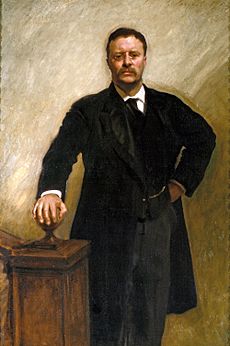
Other Artworks
Sargent also made hundreds of quick charcoal portrait sketches. He called these "Mugs." Forty-six of these were shown in an exhibition in 1916.
All of Sargent's large wall murals are in the Boston/Cambridge area. They are in the Boston Public Library, the Museum of Fine Arts, and Harvard's Widener Library. His biggest murals are called Triumph of Religion in the Boston Public Library. They show the history of religion. He worked on these for almost thirty years but never finished the last one.
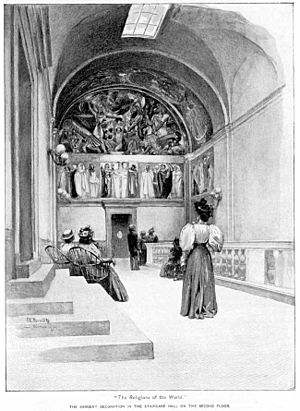
After visiting the United States, Sargent returned to England in 1918. He was hired as a war artist by the British government. In his large painting Gassed and many watercolors, he showed scenes from World War I. Sargent was deeply affected by the death of his niece, Rose-Marie, during a bombing in Paris in 1918.
Friends and Personal Life
Sargent never married. He had many friends, including men and women. Some of his friends were the writer Oscar Wilde and the artist Paul César Helleu. His friends also included famous people like Isabella Stewart Gardner, who bought his art, and King Edward VII.
Other artists Sargent knew were Dennis Miller Bunker, James Carroll Beckwith, and Claude Monet. Between 1905 and 1914, Sargent often traveled with the married artists Wilfrid de Glehn and Jane Emmet de Glehn. They would spend summers in France, Spain, or Italy, and paint each other.
Later Life and Legacy
In 1922, Sargent helped start the Grand Central Art Galleries in New York City. He was active in the galleries until he died in 1925. The galleries held a big show of his work in 1924. He then went back to England. He died at his home in Chelsea on April 14, 1925, from heart disease. Sargent is buried in Brookwood Cemetery in Surrey.
After he died, special art shows of Sargent's work were held in Boston, New York, and London.
Art Sales
Portrait of Robert Louis Stevenson and his Wife was sold in 2004 for US$8.8 million. It is now at the Crystal Bridges Museum of American Art.
In December 2004, Group with Parasols (A Siesta) (1905) sold for US$23.5 million. This was almost double what experts expected it to sell for.
Images for kids
-
Claude Monet Painting by the Edge of a Wood, 1885, the Tate, London
See also
 In Spanish: John Singer Sargent para niños
In Spanish: John Singer Sargent para niños


